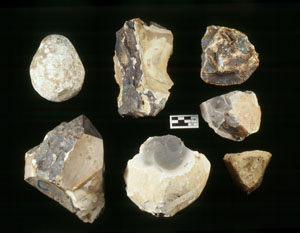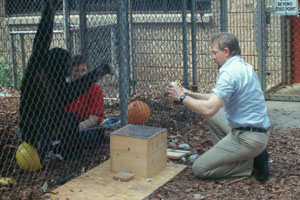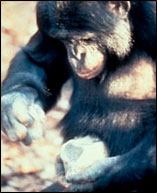Studies of Stone Tool Behavior
in Modern Apes
How skilled were early hominid tool-makers, and how do these skills compare to those among our closest living relatives, the apes?
Apes, especially chimpanzees in the wild, have a rich tool-using heritage that includes ant and termite fishing sticks, leaf sponges, and stone and wooden hammers and anvils for nut-cracking. Unfortunately, they do not intentionally flake stone in their natural settings.
Beginning in 1990, Stone Age Institute researchers Nicholas Toth and Kathy Schick, in collaboration with psychologists Sue Savage-Rumbaugh and Duane Rumbaugh at the Language Research Center in Atlanta, Georgia, have been working with African apes, especially bonobos or "pygmy chimpanzees," teaching them to make and use flaked stone tools.
Two bonobos in this study, Kanzi and his half-sister, Panbanisha, have acquired the basic skills to flake cobbles of lava, quartzite, and flint and to produce sharp-edged flakes and fragments to use for cutting activities to obtain food items. In 2005, the bonobos were moved to the Great Ape Trust in Des Moines, Iowa.
This research allows us to explore the cognitive and biomechanical skills and constraints of modern apes and helps us to assess levels of skill in early prehistoric human ancestors, and the transmission of these skills within a social group.
We have then been able to compare the tools made by modern apes to those made by early hominids and modern tool-makers, and compare and contrast the amount of finesse and skill shown by the ancient and modern species.
Here is a video clip of Kanzi making and using a stone tool.
|
Watch a video of Kanzi making and using a stone tool
These are stone artifacts modified by Kanzi during stone tool making experiments. |
Kanzi watches Nicholas Toth demonstrate stone tool technique. |
|
Kanzi flaking a stone tool. |




